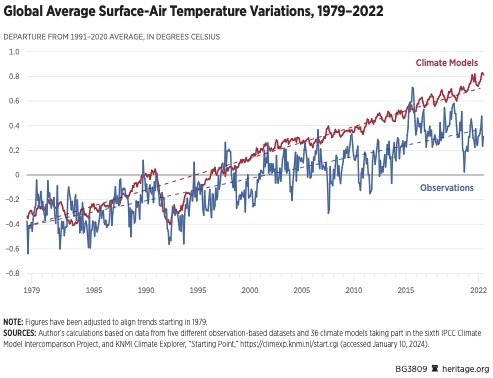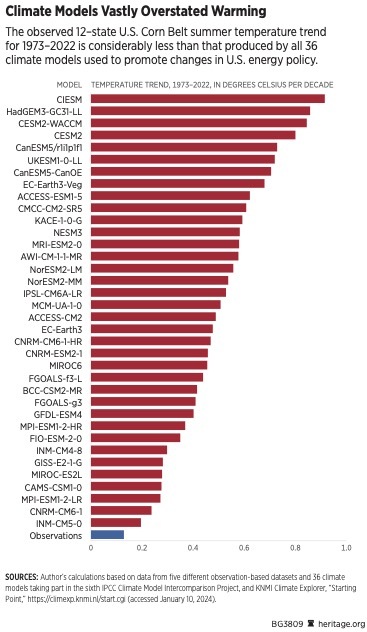- Pres. Joe Biden, Gov. Roy Cooper, and other leaders and bureaucrats would force wrenching changes to how people power their homes, drive, eat, and more in order to stave off a “climate emergency” predicted in climate change computer models
- A new paper shows how very limited the climate models are and that, as a result, they have been wildly overestimating predicted climate outcomes for half a century
- It is too dangerous and irresponsible to base policies on such uncertain and untrustworthy models
A new paper by Dr. Roy W. Spencer, principal research scientist at the University of Alabama in Huntsville in 2001 and formerly senior scientist for climate studies at NASA’s Marshall Space Flight Center, demonstrated how computerized climate models’ predictions over the years have all failed even to come close to the actual observations over the past 50 years.
One might think, So what? Climate science is extraordinarily complex. There are so many variables yet to be discovered. There is so much unknown even about the variables we know about. We can’t possibly expect computer models missing so much unknown key information to make accurate predictions.
That is entirely the point. These same models whose profound history of failure we would excuse have not been merely experimental stabs at modeling the future climate of the wide world. They have also been — and worse, are still being — used to justify enormous disruptions in our economy and how we live our lives.
Governmental policies based on averting the models’ drastic predictions would change how we power our homes, go places, cook our food, heat and cool our homes, and so forth, without any consideration of the tradeoffs. They would take away meat, homegrown vegetables, chocolate, even coffee from people and tell us to eat bugs. They would replace all of these things, especially the stuff we need to do just to survive (food and power), with undesirable replacements that cost far more, leaving us worse off in every respect. All they would leave us with is the hollow promise of averting some far-off, predicted “climate disaster.”
Government policies based on these models would, among many other things, close working power plants, forbid gas stoves and heaters, and take away meat, homegrown vegetables, chocolate, even coffee from people, and tell us to eat bugs.
To create such havoc, shouldn’t the government have rock-solid, incontrovertible, inescapable proof? As Spencer showed, no such proof exists — or even can.
A “crisis” in woefully incomplete modeling beset with uncertainty
“While the climate system has warmed somewhat over the past five decades,” he wrote, “the popular perception of a ‘climate crisis’ and resulting calls for economically significant regulations of CO2 emissions is not supported by science.”
Not only do “climate models have a history of producing more warming than has been observed in recent decades,” but policymakers favor the most inaccurate models: “those producing the greatest amount of climate change usually make their way into, for example, the U.S. National Climate Assessment, the congressionally mandated evaluation of what global climate models project for climate in the United States.”
Spencer illustrated this overprediction problem with this graph comparing models’ predictions and observations:

Above the actual, realized temperature observations were those high, modeled, but entirely unrealized extremes that were (and are) the basis for apocalyptic calls for policy changes in North Carolina, the United States, and the world.
One of the outcomes from modeled climate change is cataclysmic summer heat destroying agricultural production (that is, when the object of policy is not to destroy agriculture production itself as “bad for the climate”). In another graph, Spencer shows how far off actual temperatures were in the summers for the U.S. Corn Belt (the seat of agriculture) from “all 36 climate models used to promote changes in U.S. energy policy.” The discrepancies ranged from being off by a factor of two all the way up to overestimating by a factor of seven.

Spencer reminded readers that “global food production has increased faster than population growth in the past 60 years.” I would add that in these particular 60 years, the world’s population has well more than doubled, to 8.1 billion from three billion people in 1960. In 1968, when world population was hovering between three and four billion people, noted Malthusian alarmist Paul Ehrlich published his very influential, very ridiculous book, The Population Bomb, that opened with the dismal sentence, “The battle to feed all of humanity is over.”
What is going on? Why are climate models so wrong? Spencer detailed several problems. Among them:
- Our best measurements and instruments can capture only a tiny amount of climate energy flow — nearly all of it goes unobserved
- Models assume there is no natural source of climate change, even as climate researchers have no explanation for “the Roman Warm Period of about 2,000 years ago, the Medieval Warm Period of about 1,000 years ago, and the Little Ice Age several centuries ago” (when humanity existed without electricity, cars, heating and air conditioning, etc.)
- From there, models assume that any warming is proof of human causation (Spencer noted the “circular reasoning”)
- Models “still have problems conserving energy” — even though “[e]nergy conservation (probably the most fundamental law in science, the First Law of Thermodynamics) should be a necessary requirement of any model used for energy policy decisions”
- Even under the theoretical effects of CO2 levels in the atmosphere producing warming, great uncertainty surrounds not only how much warming could result, let alone how much warming would result from humanity’s role
- The models anticipate a doubling of atmospheric CO2 (2 x CO2) but vary wildly — by a factor of three — on the warming rates from it (from 1.8˚C to 5.6˚C), even as new research doubts whether the atmosphere could even reach 2 x CO2
- The roles of clouds and global ocean circulation, among many other factors, are completely unknown and therefore unaccounted for
Towards the end, Spencer discussed how scientists studying “accumulations of energy in the deep oceans and the observed rate of warming of the global land and ocean surface over the past 100-plus years” estimated that 2 x CO2 could lead to only 1.5˚C to 1.8˚C in total future warming. This estimate is noteworthy because “1.5˚C of future warming above pre-industrial times is often cited as a goal for a safe limit to future warming” (emphasis added).
Spencer noted the obvious conclusion: “As a result, special energy policies may not be needed to limit future warming to relatively benign levels.”
Conclusion
The shocking uncertainty and inaccuracy of the modeling behind climate policies should give anyone pause. The Biden administration pursues an aggressive climate agenda that involves trillions of dollars of incentives for favored energy sources, electric vehicles, etc., while also seeking to regulate traditional power plants, gas-fired automobiles, and a host of proven consumer choices out of markets. The Cooper administration, among other things, would automatically apply California’s regulations to North Carolina vehicles and replace working power plants with solar and offshore wind facilities while actively trying to block desperately needed new natural gas supplies and even zero-emissions nuclear.
For them, and for the North Carolina General Assembly, Spencer urged caution. “Given these uncertainties,” he said, “policymakers should proceed cautiously and not allow themselves to be influenced by exaggerated claims based on demonstrably faulty climate models.”
For more information, see:


